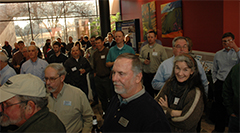

USGS scientist takes aim at Great Lakes invaders
Rising Higher: A Research Lab Built from the Ground Up - Part 2
Great Lakes Researchers Go Down Under
Rising Higher: A Research Lab Built from the Ground Up - Part 1
A Monograph on Ciscoes of the Laurentian Great Lakes and Lake Nipigon
WATCH: Acoustic Telemetry Provides In-Depth Look into Fish Behavior
Eel-Ladder Style Traps: A New Lamprey Control Tool
A Lampricide Treatment: Up-Close
Lamprey Nativeness Claims Annulled by Commission's Eshenroder
A Population at the Edge: American Eel Declining at the Extremes
Celebrating 60 Years of Successful Sea Lamprey Control, Science, and Cross-Border Collaboration!
Great Lakes Scientists Use Acoustic Telemetry to Reveal the Secret Lives of Fish
Hammond Bay Biological Station: The Nexus for Research and Restoration on the Great Lakes
Big Consequences of Small Invaders
New Sea Lamprey Estimates Suggest a Dramatically Decreased Population
Conducting Research through Cooperative Partnerships: The PERM Agreement
Living on the Edge: A Closer Look at Coastal Communities
Asian Carp: The War Isn't Over
Managing the Lake Huron Fishery
Understanding Sea Lamprey: Mapping the Genome and Identifying Pheromones
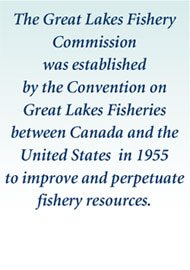
- Hammond Bay Biological Station: The Nexus for Research and Restoration on the Great Lakes
- Taking Lampreys on the Road!
- Great Lakes Scientists Use Acoustic Telemetry to Reveal the Secret Lives of Fish
- Great Lakes Fishery Commission Hosts Workshop to Explore Lampricide Resistance and the Development of Next Generation Lampricides
- Celebrating 60 Years of Successful Sea Lamprey Control, Science, and Cross-Border Collaboration!
Celebrating 60 Years of Successful Sea Lamprey Control, Science, and Cross-Border Collaboration!
In 2015, the Great Lakes Fishery Commission is excited to celebrate two momentous occasions in Great Lakes fishery management and restoration: the 60th anniversary of the Convention on Great Lakes Fisheries, which finally ended parochialism in fisheries, and the 50th anniversary of the commission's lake committees, which ensure collaboration across borders.
The convention created the commission and tasked it with controlling the destructive sea lamprey, leading research for fishery rehabilitation, and forging cross-border collaboration that, for more than a century, was missing in the Great Lakes, much to the detriment of the fish and the people who depended on them for income, recreation, and subsistence.
Sea Lamprey Control
The commission's sea lamprey control program has, without a doubt, been a critical part of the basin-wide effort to restore the fishery - and economy - after the devastation
wrecked by the sea lamprey invasion in the mid-1920s and 1930s. Over the previous sixty years, the commission and its partners have
been able to reduce sea lamprey populations by
90% in most areas of the Great Lakes - a remarkable success! Why is sea lamprey control important? Because before sea lamprey control, lampreys destroyed 103 million pounds of
fish to lamprey
Research
Sound science is, and will remain, the foundation of all commission activities. The commission's research program focuses on three key areas: fishery research, sea lamprey research, and science transfer (the latter aims to communicate research to those who will apply it). The fishery research program has supported myriad projects that have examined the interconnectedness of Great Lakes fish populations, demonstrated their vulnerability to various human-induced and natural changes, and confirmed that restoring native species - particularly predatory fish - will bring a more natural balance to the ecosystem. The sea lamprey research program, through innovative research, has developed alternative control techniques such as barriers and traps, which are now essential components of the integrated control program, and are used in conjunction with lampricides, the workhorses of the program. The commission is investing significantly into the development and implementation of pheromones - natural odors used by lampreys to communicate - and the application of knowledge gained from mapping the sea lamprey genome, both of which hold considerable promise for the future of control.
Fishery Management
Today, fishery management on the Great Lakes is more cooperative than ever. Through the non-binding agreement, A Joint Strategic Plan for Management of Great Lakes Fisheries, the fishery management agencies of the Great Lakes - eight states, one province, three U.S. intertribal agencies, and several federal agencies - have committed to manage the fishery through collaboration, consensus, strategic planning, and ecosystem-based management. The plan, which uses the commission's lake committees as "action arms," allows agencies to leverage resources, avoid duplication of effort, develop shared objectives, and exchange valuable data. The result is one of the world's finest examples of transboundary cooperation. The commission is committed to continuing its work with partners and stakeholders to build upon the existing relationships that make the Great Lakes fishery management community functional, collaborative, and successful.
As the commission reflects on its 60th anniversary and the 50th anniversary of the lake committees, the prevailing theme that continues to emerge is a strong desire to sustain past successes while continuing to adapt to the many changes that inevitably will occur on the Great Lakes. The commission's guiding principles, the effective governing institutions already in place, and the solid foundation of cooperation built over six decades, leaves the fish community ready and able to tackle the challenges of the future.

Signatories of the 1956 Convention on Great Lakes Fisheries, which created the Great Lakes Fishery Commission Photo: GLFC
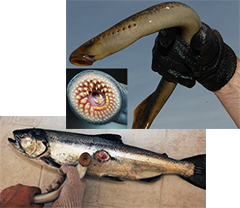
Sea lampreys use their large oral sucking disk filled with sharp, horn-shaped teeth surrounding a razor sharp rasping tongue to securely attach to a fish, rasp through the fish's scales and skin, and feed on the fish's body fluids. Photos: GLFC
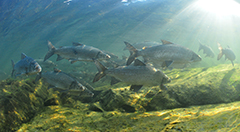
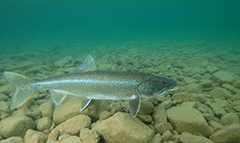
Lake trout and whitefish, two key native species of the Great Lakes, were hit particularly hard by the sea lamprey invasion. Re-establishment of native fishes has been, and will continue to be, a top research priority for the fishery research program. Photos: P. Vescei

TOP: The 1964 interim meeting of the Great Lakes Fishery Commission. It was at this meeting that the lake committee were first formed.
BOTTOM: Participants at the 50th
anniversary celebration of the lake committees. Photos: GLFC
